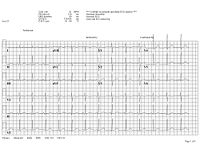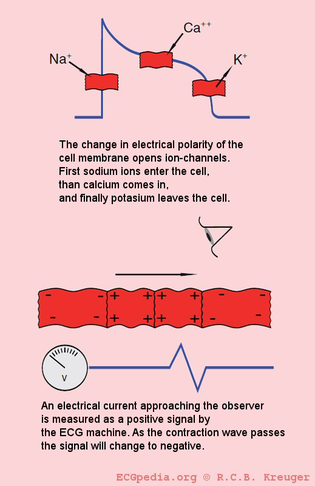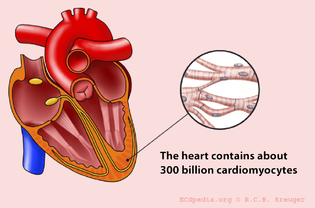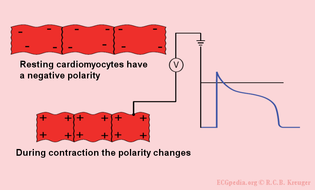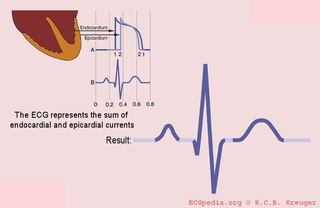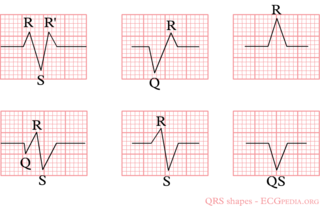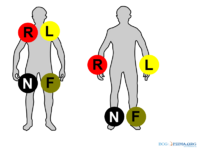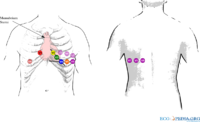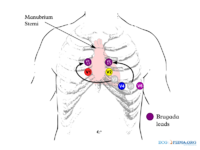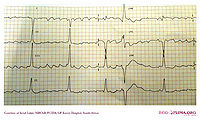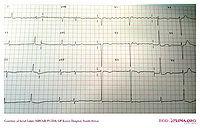Basics: Difference between revisions
| (183 intermediate revisions by 23 users not shown) | |||
| Line 1: | Line 1: | ||
=Introduction= | {{nav| | ||
[[ | |previouspage=Introduction | ||
|previousname=Introduction | |||
|nextpage=Rhythm | |||
|nextname=Step 1: Rhythm | |||
}} | |||
{{authors| | |||
|mainauthor= [[user:Vdbilt|I.A.C. van der Bilt, MD]] | |||
|supervisor= | |||
|coauthor= | |||
|moderator= [[user:Vdbilt|I.A.C. van der Bilt, MD]] | |||
|editor= | |||
}} | |||
==How do I begin to read an ECG?== | |||
{{multiple image | |||
| align = right | |||
| direction = horizontal | |||
| width = 200 | |||
| image1 = nsr.png | |||
| caption1 = A short ECG registration of normal heart rhythm (sinus rhythm) | |||
= | | image2 = Normaal ecg.jpg | ||
| caption2 = An example of a normal ECG. ''Click on the Image for an enlargement'' | |||
}} | |||
Click on the ECG to see an enlargement. | Click on the ECG to see an enlargement. | ||
Where do | Where do you start when interpreting an ECG? | ||
* top left are the patient's information, name, sex and date of birth | * On the top left are the patient's information, name, sex and date of birth | ||
* | * At the right of that are below each other the [[Frequency]], the [[Conduction|conduction times]] (PQ,QRS,QT/QTc), and the [[heart axis]] (P-top axis, QRS axis and T-top axis) | ||
* | * Farther to the right is the interpretation of the ECG written (this may be missing in a 'fresh' ECG, but later the interpretation of the cardiologist or computer will be added) | ||
* | * Down left is the 'paper speed' (25 mm/s on the horizontal axis), the sensitivity (10mm/mV) and the filter's frequency (40Hz, filters noise from eg. lights). | ||
* | * There is a calibration. At the beginning of every lead is a vertical block that shows with what amplitude a 1 mV signal is drawn. So the height and depth of these signals are a measurement for the voltage. If this is not set at 10 mm, there is something wrong with the machine setting. | ||
* | * Finally we have the ECG leads themselves.These will be discussed below. | ||
Note the | Note that the layout is different for each machine, but most machines will show the information above somewhere. | ||
{{clr}} | {{clr}} | ||
=What does the ECG register?= | ==What does the ECG register?== | ||
;The electrocardiogram: An electrocardiogram (ECG or EKG) is a register of the heart's electrical activity. | |||
Just like skeletal muscles, heart muscles are electrically stimulated to contract. This stimulation is also called ''activation'' or ''excitation''. Cardiac muscles are electrically charged at rest. The inside of the cell is negatively charged relative to the outside (resting potential). If the cardiac muscle cells are electrically stimulated, they depolarize (the resting potential changes from negative to positive) and contract. The electrical activity of a single cell can be registered as the [[action potential]]. | |||
As the electrical impulse spreads through the heart, the electrical field changes continually in size and direction. The ECG is a graph of these electrical cardiac signals. | |||
==The ECG represents the sum of the action potentials of millions of cardiomyocytes== | |||
{{multiple image | |||
| align = right | |||
| direction = horizontal | |||
| width = 315 | |||
= | | image1 = Ion_currents_en.png | ||
| caption1 = Ion currents of the cardiomyocytes | |||
[[ | | image2 = Hart_cells_en.png | ||
| caption2 = The heart consists of approximately 300 billion cells | |||
| image3 = cells_in_rest_en.png | |||
| caption3 = In rest the heart cells are negatively charged. Through the depolarization by surrounding cells they become positively charged and they contract. | |||
}} | |||
{| class="wikitable" border="1" style="float: left" | |||
|- | |||
| align="center" width="800" | {{#widget:Html5media | |||
|url=https://en.ecgpedia.org/images/8/88/Single_cardiomyocyte.mp4 | |||
|width=640 | |||
|height=360 | |||
}} | |||
| rowspan="2" align="center" width="800" | <youtube width="560">j9w1qylp4TY</youtube> | |||
|- | |||
| width="800" | <small>This movie shows the contraction of a single (rabbit) heart cell. The glass electrode measures the electrical current in the heart cell (with the[[w:Patch_clamp|patch-clamp method]]). The electrical signal is written in blue and shows the action potential. ''Courtesy of Arie Verkerk and Antoni van Ginneken, AMC, Amsterdam, The Netherlands''.</small> | |||
|} | |||
The individual [[action potential|action potentials]] of the individual cardiomyocytes are averaged. The final result, which is shown on the ECG, is actually the average of billions of microscopic electrical signals. | |||
During the depolarization, sodium ions stream into the cell. Subsequently, the calcium ions stream into the cell. These calcium ions cause the actual muscular contraction. | |||
Finally the potassium ions stream out of the cell. During repolarization the ion concentration returns to its precontraction state. On the ECG, an action potential wave coming toward the electrode is shown as a positive (upwards) signal. Here the ECG electrode is represented as an eye. | |||
{{clr}} | {{clr}} | ||
= | ==The electric discharge of the heart== | ||
[[Image:conduction_system. | [[Image:conduction_system.svg|thumb|450px|left|The conduction system of the heart]] | ||
{| class="wikitable" border="1" style="float: right" | |||
|- | |||
|align="center" | {{#widget:Html5media | |||
|url=https://en.ecgpedia.org/images/4/40/Normal_SR_vector.mp4 | |||
|width=640 | |||
|height=360 | |||
}} | |||
|} | |||
''' | '''The sinoatrial node (SA node) contains the fastest physiological pacemaker cells of the heart; therefore, they determine the [[Rate|heart rate]].''' | ||
'''First the [[heart|atria]] depolarize and contract. After that the [[heart|ventricles]]''' depolarize and contract. | |||
The electrical signal between the atria and the ventricles goes from the sinus node via the atria to the AV-node (atrioventricular transition) to the His bundle and subsequently to the right and left bundle branches, which end in a dense network of Purkinje fibers. | |||
The depolarization of the heart results in an electrical force which has a direction and magnitude; an electrical vector. This vector changes every millisecond of the depolarization. In the animation vectors for atrial depolarization, ventricular depolarization and ventricular repolarization are shown. | |||
{{clr}} | {{clr}} | ||
=The | ==The different ECG waves== | ||
[[ | [[File:PQRS_origin_en.png|thumb|left|300px|The origin of the different waves on the ECG]] | ||
{{multiple image | |||
| align = right | |||
| direction = vertical | |||
| width = 320 | |||
| image1 = Epi_endo_en.png | |||
| caption1 = The QRS complex is formed by the sum of the electric avtivity of the inner (endocardial) and the outer (epicardial) cardiomyocytes | |||
| image2 = Qrs-shapes.png | |||
| caption2 = Example of the different QRS configurations | |||
}} | |||
The [[P_wave_morphology|'''P wave''']] is the result of the atrial depolarization. This depolarization starts in the SA (sinoatrial) node. The signal produced by pacemaker cells in the SA node is conducted to the right and left atria. Normal atrial repolarization is not visible on the ECG (but can be visible during [[atrial infarction]] and [[pericarditis]]). | |||
The [[QRS_morphology|'''QRS complex''' ]] is the average of the depolarization waves of the inner (endocardial) and outer (epicardial) cardiomyocytes. As the endocardial cardiomyocytes depolarize slightly earlier than the outer layers, a typical QRS pattern occurs (figure). | |||
[[ | The [[ST_morphology|'''T wave''']] represents the repolarization of the ventricles. There is no cardiac muscle activity during the T wave. | ||
One heart beat consists of an atrial depolarization --> atrial contraction --> p-wave, ventricular depolarization --> ventricular contraction --> ORS-complex and the resting phase (including the repolarization during the T-wave) between two heart beats. | |||
Have a look at this [[http://www-medlib.med.utah.edu/kw/pharm/hyper_heart1.html animation of the heart cycle]] | |||
The origin of the '''U wave''' is unknown. This wave possibly results from "afterdepolarizations" of the ventricles. | |||
The letters "Q", "R" and "S" are used to describe the QRS complex | |||
*Q: the first negative deflection after the p-wave. If the first deflection is not negative, the Q is absent. | |||
*R: the positive deflection | |||
*S: the negative deflection after the R-wave | |||
*Small print letters (q, r, s) are used to describe deflections of small amplitude. For example: qRS = small q, tall R, deep S. | |||
*R`: is used to describe a second R-wave (as in a [[RBBB|right bundle branch block]]) | |||
See figure for some examples of this. | |||
{{clr}} | |||
==The history of the ECG== | |||
A [[A_Concise_History_of_the_ECG| concise history of the ECG]] is presented in a different chapter. | |||
[[ | |||
{{clr}} | {{clr}} | ||
= | ==The ECG electrodes== | ||
{{multiple image | |||
| align = right | |||
| direction = vertical | |||
| width = 200 | |||
| image1 = limb_leads.png | |||
| caption1 = The limb leads | |||
| image2 = chest_leads.png | |||
| caption2 = The chest leads | |||
}} | |||
Electrical activity going through the heart can be measured by external (skin)electrodes. The electrocardiogram (ECG) registers these activities from electrodes which have been attached onto different places on the body. In total, twelve leads are calculated using ten electrodes. | |||
The ten electrodes are: | |||
* '''The four extremity electrodes:''' | |||
** LA - left arm | |||
** RA - right arm | |||
** N - neutral, on the right leg (= electrical earth, or point zero, to which the electrical current is measured) | |||
** F - foot, on the left leg | |||
It makes no difference whether the electrodes are attached proximal or distal on the extremities. ''However'', it is best to be uniform in this. (eg. do not attach an electrode on the left shoulder and one on the right wrist). | |||
* '''The six chest electrodes:''' | |||
** V1 - placed in the 4th intercostal space, right of the sternum | |||
** V2 - placed in the 4th intercostal space, left of the sternum | |||
** V3 - placed between V2 and V4 | |||
** V4 - placed 5th intercostal space in the nipple line. Official recommendations are to place V4 under the breast in women.<cite>Kligfield</cite> | |||
** V5 - placed between V4 and V6 | |||
** V6 - placed in the midaxillary line on the same height as V4 (horizontal line from V4, so not necessarily in the 5th intercostal space) | |||
{{clr}} | {{clr}} | ||
= | With the use of these 10 electrodes, 12 leads can be derived. There are 6 extremity leads and 6 precordial leads. | ||
[[ | ===The Extremity Leads=== | ||
[[File:ECGafleidingen.jpg|thumb|left|200px]] | |||
The extremity leads are: | |||
*'''I''' from the right to the left arm | |||
* ''' | *'''II''' from the right arm to the left leg | ||
* | *'''III''' from the left arm to the left leg | ||
* | An easy rule to remember: lead '''I''' + lead '''III''' = lead '''II''' | ||
This is done with the use of the height or depth, independent of the wave (QRS, P of T). | |||
Example: if in lead I, the QrS complex is 3 mm in height and in lead III 9mm, the height of the QRS-complex in lead II is 12mm. | |||
Other extremity leads are: | |||
*'''AVL''' points to the left arm | |||
*'''AVR''' points to the right arm | |||
*'''AVF''' points to the feet | |||
The capital A stands for "augmented" and V for "voltage". | |||
(aVR + aVL + aVF = 0) | |||
{{clr}} | {{clr}} | ||
===The Chest Leads=== | |||
== | The precordial, or chest leads, '''(V1,V2,V3,V4,V5 and V6)''' 'observe' the depolarization wave in the frontal plane. | ||
''Example'': V1 is close to the right ventricle and the right atrium. Signals in these areas of the heart have the largest signal in this lead. V6 is the closest to the lateral wall of the left ventricle. | |||
==ECG variants== | |||
Besides the standard 12 lead ECG a couple of variants are in use: | |||
*The '''3 channel ECG''' uses 3 or 4 ECG electrodes. Red is on the right, yellow on the left arm, green on the left leg ('sun shines on the grass') and black on the right leg. These basic leads yield enough information for rhythm-monitoring. For determination of ST elevation, these basic leads are inadequate as there is no lead that gives (ST) information about the anterior wall. ST changes registered during 3-4 channel ECG monitoring should prompt acquisition of a 12 lead ECG. | |||
*The '''5 channel ECG''' uses 4 extremitiy leads and 1 precordial lead. This improves ST segment accuracy, but is still inferior to a 12 lead ECG. <cite>drew</cite><cite>Klootwijk</cite> | |||
*In '''vector electrocardiography''' the movement of electrical acitivity of the P, QRS and T wave is described. Additional X,Y and Z leads are recorded. Vector electrocardiography is rarely used nowadays, but is sometimes useful in a research setting. | |||
*In '''body surface mapping''' several arrays are used to accurately map the cardiac electrical wavefront as it moves over de body surface. With this information the electrical acitivity of the heart can be calculated. This is sometimes used in a research setting. | |||
==Color coding of the ECG leads== | |||
Two systems for ECG lead color coding are used: the AHA (''American Heart Association'') system and the IEC (''International Electrotechnical Commission'') system: | |||
{| class="wikitable" cellpadding="7" | |||
|| | |||
| colspan="2" | AHA (''American Heart Association'') | |||
| colspan="2" | IEC (''International Electrotechnical Commission'') | |||
|- | |||
!| Location | |||
!| Inscription | |||
!| Colour | |||
!| Inscription | |||
!| Colour | |||
|- | |||
|- | |||
| | Right Arm | |||
!| RA | |||
| | White | |||
!|R | |||
| | Red | |||
|- | |||
| | Left Arm | |||
!|LA | |||
| | Black | |||
!|L | |||
| | Yellow | |||
|- | |||
| | Right Leg | |||
!|RL | |||
| | Green | |||
!|N | |||
| | Black | |||
|- | |||
| | Left Leg | |||
!|LL | |||
| | Red | |||
!|F | |||
| | Green | |||
|- | |||
| | Chest | |||
!|V1 | |||
| | Brown/Red | |||
!|C1 | |||
| | White/Red | |||
|- | |||
| | Chest | |||
!|V2 | |||
| | Brown/Yellow | |||
!|C2 | |||
| | White/Yellow | |||
|- | |||
| | Chest | |||
!|V3 | |||
| | Brown/Green | |||
!|C3 | |||
| | White/Green | |||
|- | |||
| | Chest | |||
!|V4 | |||
| | Brown/Blue | |||
!|C4 | |||
| | White/Brown | |||
|- | |||
| | Chest | |||
!|V5 | |||
| | Brown/Orange | |||
!|C5 | |||
| | White/Black | |||
|- | |||
| | Chest | |||
!|V6 | |||
| | Brown/Purple | |||
!|C6 | |||
| | White/Violet | |||
|} | |||
==Special Leads== | |||
{{multiple image | |||
| align = left | |||
| direction = horizontal | |||
| width = 200 | |||
| image1 = leads_789.png | |||
| caption1 = Leads V7,V8 and V9 can be helpful in the diagnosis of posterior myocardial infarction | |||
| image2 = Brugada_lead_placement.png | |||
{{ | | caption2 = Changed lead positions of leads V3 and V5 to increase the sensitiviy to 'catch' a [[Brugada]] pattern on the ECG. | ||
}} | |||
{{multiple image | |||
| align = right | |||
| direction = vertical | |||
| width = 200 | |||
| image1 = E000559.jpg | |||
| caption1 = A patient with atrial fibrillation with a 'Lewis Lead' positioning of the leads. Compared with the normal lead configuration, the atrial signal is enlarged. Although some parts have a 'sawtooth' appearance consistent with atrial flutter, the rhythm is atrial fibrillation as there is a changing pattern in the atrial activity. | |||
== | | image2 = E000557.jpg | ||
| caption2 = The same patient with a normal lead configuration. The rhythm is atrial fibrillation. The atrial activity in lead V1 is organized probably due to a organisation of electrical activity after it enters the right atrial appendage, close to lead V1. | |||
}} | |||
Throughout history extra lead positions have been tried. Most are rarely used in practice, but they can deliver very valuable diagnostic clues in specific cases. | |||
*Leads to improve diagnosis in '''right ventricular en posterior infarction''': | |||
In case of an inferior wall infarct, extra leads may be used: | |||
:::: 1. On a right-sided ECG, V1 and V2 remain on the same place. V3 to V6 are placed on the same place but mirrored on the chest. So V4 is in the middle of the right clavicle. The ECG should be marked as a ''Right-sided ECG''. V4R (V4 but right sided) is a sensitive lead for diagnosing right ventricular infarctions. | |||
:::: 2. Leads V7-V8-V9 can be used to diagnose a posterior infarct. After V6, leads are placed towards the back. See the chapter [[Ischemia]] for other ways of diagnosing posterior infarction. | |||
*Leads to improve detection of '''atrial rhythm''': | |||
::In wide complex tachycardia, good detection of atrial rhythm and atrio-ventricular dissociation can be very helpful in the diagnosis process. An esophagal ECG electrode placed close to the atria can be helpful. Another, less invasive, method is the '''Lewis Lead'''. This is recorded by changing the limb electrodes, placing the right arm electrode in the second intercostal space and the left arm electrode in the fourth intercostal space, both to the right of the sternum. Furthermore gain is increased to 20mm/mV and paper speed to 50mm/sec.<cite>Lewis1</cite>ß | |||
*Lead positioning to enhance detection of [[Brugada]] syndrome | |||
{{clr}} | |||
==Ladder diagram== | |||
[[File:Ladder_diagram.svg|thumb|right|A ladder diagram is a diagram that shows the presumed origin of impulse formation and conduction in the heart. A = atrial, AV = AV node, V = ventricles]] | |||
A ladder diagram is a diagram to explain arrhythmias. The figure shows a simple ladder diagram for normal sinus rhythm, followed by av-nodal extrasystole. The origin of impulse formation (sinus node for the first two beats and AV junction for the third beat) and the conduction in the heart are shown. | |||
<br /><br /> | |||
<br /><br /> | |||
<br /><br /> | |||
<br /><br /> | |||
<br /><br /> | |||
<br /><br /> | |||
==Technical Problems== | |||
Also read the chapter about [[Technical Problems]]. That will help you recognize electrical disturbances and lead reversals. | |||
= | {{box| | ||
==References== | |||
<biblio> | |||
#Dubois Du Bois-Reymond, E. ''Untersuchungen über thierische Elektricität''. Reimer, Berlin: 1848. | |||
#Hoffa Hoffa M, Ludwig C. 1850. ''Einige neue versuche uber herzbewegung''. Zeitschrift Rationelle Medizin, 9: 107-144 | |||
#Waller Waller AD. ''A demonstration on man of electromotive changes accompanying the heart's beat.'' J Physiol (London) 1887;8:229-234 | |||
#Einthoven Einthoven W. ''Le telecardiogramme''. Arch Int de Physiol 1906;4:132-164 | |||
#Einthoven2 Einthoven W. ''Über die Form des menschlichen Electrocardiogramms''. Pfügers Archiv maart 1895, pagina 101-123 | |||
#Marey Marey EJ. ''Des variations electriques des muscles et du couer en particulier etudies au moyen de l'electrometre de M Lippman.'' Compres Rendus Hebdomadaires des Seances de l'Acadamie des sciences 1876;82:975-977 | |||
#Marquez pmid=12177632 | |||
#Hurst pmid=9799216 | |||
#Kligfield pmid=17322457 | |||
#Lewis1 pmid=20022196 | |||
</biblio> | |||
}} | |||
[[nl:Grondbeginselen]] | [[nl:Grondbeginselen]] | ||
[[Category:ECG Course]] | |||
Latest revision as of 12:41, 14 May 2025
| «Introduction | Step 1: Rhythm» |
| Author(s) | I.A.C. van der Bilt, MD | |
| Moderator | I.A.C. van der Bilt, MD | |
| Supervisor | ||
| some notes about authorship | ||
How do I begin to read an ECG?
Click on the ECG to see an enlargement. Where do you start when interpreting an ECG?
- On the top left are the patient's information, name, sex and date of birth
- At the right of that are below each other the Frequency, the conduction times (PQ,QRS,QT/QTc), and the heart axis (P-top axis, QRS axis and T-top axis)
- Farther to the right is the interpretation of the ECG written (this may be missing in a 'fresh' ECG, but later the interpretation of the cardiologist or computer will be added)
- Down left is the 'paper speed' (25 mm/s on the horizontal axis), the sensitivity (10mm/mV) and the filter's frequency (40Hz, filters noise from eg. lights).
- There is a calibration. At the beginning of every lead is a vertical block that shows with what amplitude a 1 mV signal is drawn. So the height and depth of these signals are a measurement for the voltage. If this is not set at 10 mm, there is something wrong with the machine setting.
- Finally we have the ECG leads themselves.These will be discussed below.
Note that the layout is different for each machine, but most machines will show the information above somewhere.
What does the ECG register?
- The electrocardiogram
- An electrocardiogram (ECG or EKG) is a register of the heart's electrical activity.
Just like skeletal muscles, heart muscles are electrically stimulated to contract. This stimulation is also called activation or excitation. Cardiac muscles are electrically charged at rest. The inside of the cell is negatively charged relative to the outside (resting potential). If the cardiac muscle cells are electrically stimulated, they depolarize (the resting potential changes from negative to positive) and contract. The electrical activity of a single cell can be registered as the action potential. As the electrical impulse spreads through the heart, the electrical field changes continually in size and direction. The ECG is a graph of these electrical cardiac signals.
The ECG represents the sum of the action potentials of millions of cardiomyocytes
| This movie shows the contraction of a single (rabbit) heart cell. The glass electrode measures the electrical current in the heart cell (with thepatch-clamp method). The electrical signal is written in blue and shows the action potential. Courtesy of Arie Verkerk and Antoni van Ginneken, AMC, Amsterdam, The Netherlands. |
The individual action potentials of the individual cardiomyocytes are averaged. The final result, which is shown on the ECG, is actually the average of billions of microscopic electrical signals.
During the depolarization, sodium ions stream into the cell. Subsequently, the calcium ions stream into the cell. These calcium ions cause the actual muscular contraction.
Finally the potassium ions stream out of the cell. During repolarization the ion concentration returns to its precontraction state. On the ECG, an action potential wave coming toward the electrode is shown as a positive (upwards) signal. Here the ECG electrode is represented as an eye.
The electric discharge of the heart
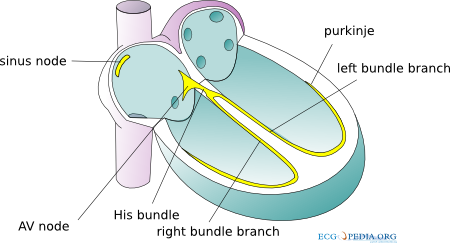
The sinoatrial node (SA node) contains the fastest physiological pacemaker cells of the heart; therefore, they determine the heart rate.
First the atria depolarize and contract. After that the ventricles depolarize and contract.
The electrical signal between the atria and the ventricles goes from the sinus node via the atria to the AV-node (atrioventricular transition) to the His bundle and subsequently to the right and left bundle branches, which end in a dense network of Purkinje fibers.
The depolarization of the heart results in an electrical force which has a direction and magnitude; an electrical vector. This vector changes every millisecond of the depolarization. In the animation vectors for atrial depolarization, ventricular depolarization and ventricular repolarization are shown.
The different ECG waves
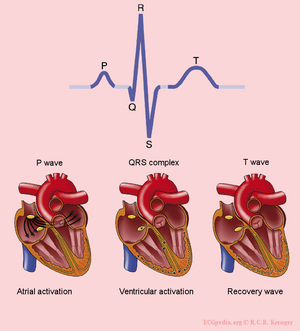
The P wave is the result of the atrial depolarization. This depolarization starts in the SA (sinoatrial) node. The signal produced by pacemaker cells in the SA node is conducted to the right and left atria. Normal atrial repolarization is not visible on the ECG (but can be visible during atrial infarction and pericarditis).
The QRS complex is the average of the depolarization waves of the inner (endocardial) and outer (epicardial) cardiomyocytes. As the endocardial cardiomyocytes depolarize slightly earlier than the outer layers, a typical QRS pattern occurs (figure).
The T wave represents the repolarization of the ventricles. There is no cardiac muscle activity during the T wave.
One heart beat consists of an atrial depolarization --> atrial contraction --> p-wave, ventricular depolarization --> ventricular contraction --> ORS-complex and the resting phase (including the repolarization during the T-wave) between two heart beats.
Have a look at this [animation of the heart cycle]
The origin of the U wave is unknown. This wave possibly results from "afterdepolarizations" of the ventricles.
The letters "Q", "R" and "S" are used to describe the QRS complex
- Q: the first negative deflection after the p-wave. If the first deflection is not negative, the Q is absent.
- R: the positive deflection
- S: the negative deflection after the R-wave
- Small print letters (q, r, s) are used to describe deflections of small amplitude. For example: qRS = small q, tall R, deep S.
- R`: is used to describe a second R-wave (as in a right bundle branch block)
See figure for some examples of this.
The history of the ECG
A concise history of the ECG is presented in a different chapter.
The ECG electrodes
Electrical activity going through the heart can be measured by external (skin)electrodes. The electrocardiogram (ECG) registers these activities from electrodes which have been attached onto different places on the body. In total, twelve leads are calculated using ten electrodes.
The ten electrodes are:
- The four extremity electrodes:
- LA - left arm
- RA - right arm
- N - neutral, on the right leg (= electrical earth, or point zero, to which the electrical current is measured)
- F - foot, on the left leg
It makes no difference whether the electrodes are attached proximal or distal on the extremities. However, it is best to be uniform in this. (eg. do not attach an electrode on the left shoulder and one on the right wrist).
- The six chest electrodes:
- V1 - placed in the 4th intercostal space, right of the sternum
- V2 - placed in the 4th intercostal space, left of the sternum
- V3 - placed between V2 and V4
- V4 - placed 5th intercostal space in the nipple line. Official recommendations are to place V4 under the breast in women.Kligfield
- V5 - placed between V4 and V6
- V6 - placed in the midaxillary line on the same height as V4 (horizontal line from V4, so not necessarily in the 5th intercostal space)
With the use of these 10 electrodes, 12 leads can be derived. There are 6 extremity leads and 6 precordial leads.
The Extremity Leads
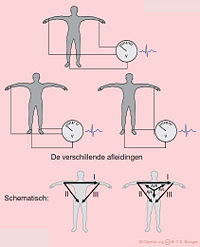
The extremity leads are:
- I from the right to the left arm
- II from the right arm to the left leg
- III from the left arm to the left leg
An easy rule to remember: lead I + lead III = lead II This is done with the use of the height or depth, independent of the wave (QRS, P of T). Example: if in lead I, the QrS complex is 3 mm in height and in lead III 9mm, the height of the QRS-complex in lead II is 12mm.
Other extremity leads are:
- AVL points to the left arm
- AVR points to the right arm
- AVF points to the feet
The capital A stands for "augmented" and V for "voltage".
(aVR + aVL + aVF = 0)
The Chest Leads
The precordial, or chest leads, (V1,V2,V3,V4,V5 and V6) 'observe' the depolarization wave in the frontal plane.
Example: V1 is close to the right ventricle and the right atrium. Signals in these areas of the heart have the largest signal in this lead. V6 is the closest to the lateral wall of the left ventricle.
ECG variants
Besides the standard 12 lead ECG a couple of variants are in use:
- The 3 channel ECG uses 3 or 4 ECG electrodes. Red is on the right, yellow on the left arm, green on the left leg ('sun shines on the grass') and black on the right leg. These basic leads yield enough information for rhythm-monitoring. For determination of ST elevation, these basic leads are inadequate as there is no lead that gives (ST) information about the anterior wall. ST changes registered during 3-4 channel ECG monitoring should prompt acquisition of a 12 lead ECG.
- The 5 channel ECG uses 4 extremitiy leads and 1 precordial lead. This improves ST segment accuracy, but is still inferior to a 12 lead ECG. drewKlootwijk
- In vector electrocardiography the movement of electrical acitivity of the P, QRS and T wave is described. Additional X,Y and Z leads are recorded. Vector electrocardiography is rarely used nowadays, but is sometimes useful in a research setting.
- In body surface mapping several arrays are used to accurately map the cardiac electrical wavefront as it moves over de body surface. With this information the electrical acitivity of the heart can be calculated. This is sometimes used in a research setting.
Color coding of the ECG leads
Two systems for ECG lead color coding are used: the AHA (American Heart Association) system and the IEC (International Electrotechnical Commission) system:
| AHA (American Heart Association) | IEC (International Electrotechnical Commission) | |||
| Location | Inscription | Colour | Inscription | Colour |
|---|---|---|---|---|
| Right Arm | RA | White | R | Red |
| Left Arm | LA | Black | L | Yellow |
| Right Leg | RL | Green | N | Black |
| Left Leg | LL | Red | F | Green |
| Chest | V1 | Brown/Red | C1 | White/Red |
| Chest | V2 | Brown/Yellow | C2 | White/Yellow |
| Chest | V3 | Brown/Green | C3 | White/Green |
| Chest | V4 | Brown/Blue | C4 | White/Brown |
| Chest | V5 | Brown/Orange | C5 | White/Black |
| Chest | V6 | Brown/Purple | C6 | White/Violet |
Special Leads
Throughout history extra lead positions have been tried. Most are rarely used in practice, but they can deliver very valuable diagnostic clues in specific cases.
- Leads to improve diagnosis in right ventricular en posterior infarction:
In case of an inferior wall infarct, extra leads may be used:
- 1. On a right-sided ECG, V1 and V2 remain on the same place. V3 to V6 are placed on the same place but mirrored on the chest. So V4 is in the middle of the right clavicle. The ECG should be marked as a Right-sided ECG. V4R (V4 but right sided) is a sensitive lead for diagnosing right ventricular infarctions.
- 2. Leads V7-V8-V9 can be used to diagnose a posterior infarct. After V6, leads are placed towards the back. See the chapter Ischemia for other ways of diagnosing posterior infarction.
- Leads to improve detection of atrial rhythm:
- In wide complex tachycardia, good detection of atrial rhythm and atrio-ventricular dissociation can be very helpful in the diagnosis process. An esophagal ECG electrode placed close to the atria can be helpful. Another, less invasive, method is the Lewis Lead. This is recorded by changing the limb electrodes, placing the right arm electrode in the second intercostal space and the left arm electrode in the fourth intercostal space, both to the right of the sternum. Furthermore gain is increased to 20mm/mV and paper speed to 50mm/sec.Lewis1ß
- Lead positioning to enhance detection of Brugada syndrome
Ladder diagram

A ladder diagram is a diagram to explain arrhythmias. The figure shows a simple ladder diagram for normal sinus rhythm, followed by av-nodal extrasystole. The origin of impulse formation (sinus node for the first two beats and AV junction for the third beat) and the conduction in the heart are shown.
Technical Problems
Also read the chapter about Technical Problems. That will help you recognize electrical disturbances and lead reversals.
{{{1}}}

